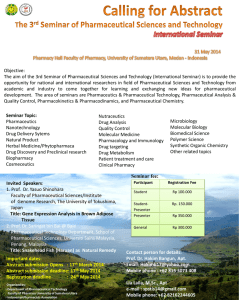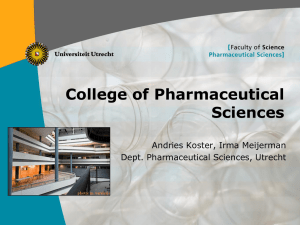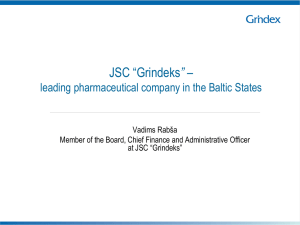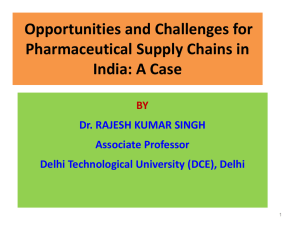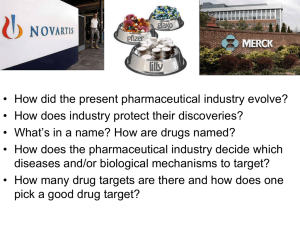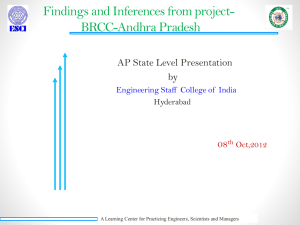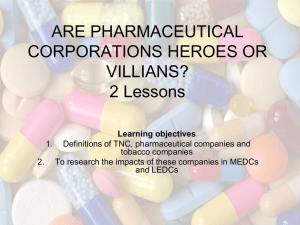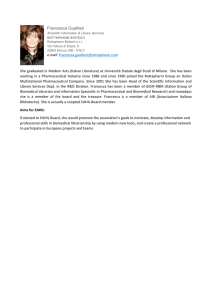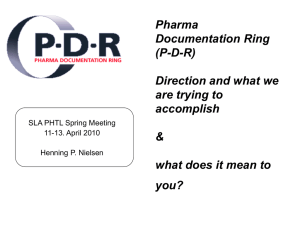Chapter 15
advertisement
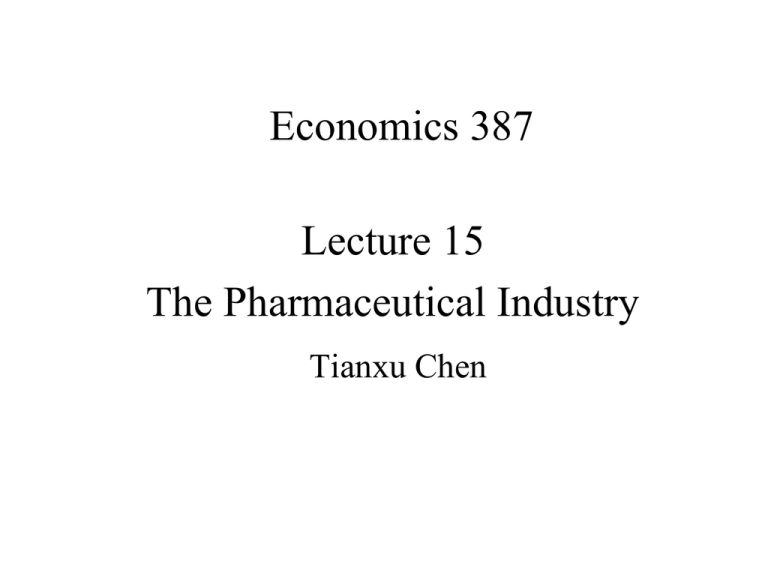
Economics 387 Lecture 15 The Pharmaceutical Industry Tianxu Chen Outline • Structure and Regulation • The Production of Health and Substitutability • Drug Pricing and Profits • R&D and Innovation • Cost Containment • New Drugs and Health Care Spending • Conclusions Overview • Prescription drugs and the pharmaceutical industry occupy increasingly important places in the health economy. • Drug therapies traditionally have supplemented nutrition, sanitation, and medical care as methods for preserving health. • Despite these successes, the U.S. pharmaceutical industry has been under intense media and legislative scrutiny. Pharmaceutical firms are among the largest and most profitable businesses in the United States. Overview • After describing the structure and regulation of the pharmaceutical industry, we focus on the following areas: - The role of pharmaceutical products in the production of health, patient choices of drugs under various insurance schemes, and the effects of technological change on the use of drugs - Drug pricing issues, including price discrimination by sellers and price regulation by the government - Pharmaceutical research, the determinants of innovation, and the effects of price regulation on innovation - Cost containment through use of generic products and other measures STRUCTURE AND REGULATION Overview • In 2009, spending on prescription drugs amounted to $250 billion or 10.1 percent of national health expenditures, up from 8.8 percent in 2000 and just 4.7 percent in 1980. • With its long history of relatively high profits and rich set of features—patent protection, high research and development spending, intense product promotion, and heavy regulation—the pharmaceutical industry always has drawn the attention of economists in the field of industrial organization. Table 17-1 Concentration in Selected Manufacturing Industries: 2002 Competition • The four-firm (C4) and eight-firm (C8) concentration ratios for any selected sixdigit NAICS codes indicate the share of industry output produced by the four or eight largest firms. • Based on concentration ratios, the pharmaceutical industry appears to be much more competitive than many others. Barriers to Entry • A barrier to entry is any factor that impedes the entry of new firms into an industry or product market. Patent protection granted by government represents a classic example. • To gain further protection, pharmaceutical firms adopt a common business strategy of surrounding a product with patents on many variations of that product. Barriers to Entry • Advertising and promotion also can create economic barriers when they successfully increase brand loyalty. • As a last example of protection from competition, the regulation of drugs itself can create entry barriers. Regulation • The pharmaceutical industry is one of the most heavily regulated of all industries. • FDA review has become a lengthy, complex process. The FDA review usually takes more than a year. Total development time for a new product stands at about 14 years, nearly double the eight-year period in the 1960s (DiMasi, 2001). THE PRODUCTION OF HEALTH AND SUBSTITUTABILITY • Consider the role of prescription drugs in producing health and their relationship to other medical inputs using the concept of a health production function. • Consider the following production function: HS = f(D,M) where HS is a patient’s health status, D is prescription drugs and M other health inputs. Overview • There are three different effects of drug products and their relationship to other medical inputs: - Drugs may have to be used in fixed proportions relative to other inputs. - Drugs and other inputs may be perfect substitutes for one another. - Drugs and other inputs may be able to be substituted for one another but subject to diminishing marginal rate of technical substitution. Figure 17-1 Substitution Between Drugs and Other Medical Inputs Least-Cost Production • Patients and providers will choose the combination of inputs that produces the level of health desired at least cost. • As prescription costs rise, rational consumers will substitute the now relatively cheaper other medical inputs into the production of health. Figure 17-2 Cost Minimization Insurance and Substitutability • If insurance policies more generously cover prescription drugs than they do medical inputs, rational consumers will substitute prescription drugs for medical inputs in the production process. DRUG PRICING AND PROFITS • Many studies have found that pharmaceutical profits, as reported in financial statements, are consistently among the highest of all industries. Monopoly Pricing • The profit-maximizing output occurs where MC equals MR. The monopolist then charges the highest price the market will bear, which is given by the demand curve. If price exceeds average cost a profit will be earned. • Lu and Comanor (1998) examined pricing decisions on new products, and their findings support profit-maximization. Figure 17-4 Drug Pricing Price Discrimination • With monopoly power, pharmaceutical companies may be able to engage in third degree price discrimination. That is, segmenting the market according to differing elasticity of demand and charging higher prices to those segments with the more inelastic demand. Figure 17-5 Price Discriminations Monopsony Pricing and Price Controls • Price discrimination is not the only possible explanation for price differentials. Prices in some foreign countries can be lower because their governments regulate prices or their national health plan serves as a monopsony buyer. Competition and Generic Entry • Once a patent expires, other firms can enter the market. • Wiggins and Maness (2004) estimated an 83 percent drop in prices of anti-infectives (e.g., penicillins, tetracyclines) as the number of sellers increases from 1 to between 6 and 15, with further drops in price as more firms enter the market. R&D AND INNOVATION Overview • Domestic R&D expenditures for members of the Pharmaceutical Research & Manufacturers of America (research-based pharmaceutical firms) rose from just over $1.5 billion in 1980 to $37.4 billion in 2010 (PhRMA, 2011). • Patents provide protection for pharmaceutical companies so they are able to recover these R&D expenditures. Overview • Mansfield (1986) found that 60 percent of pharmaceutical drugs between 1981 and 1983 would not have been developed without patent protection. • Although the effects of the patent system are small in most industries, it is critical to pharmaceutical innovation. Investment Decisions • Net present value is: – where Rt and Ct represent the revenue and costs in time t, r is the cost of capital and T is the life of the project Investment Decisions • Pharmaceutical R&D projects can be broken into 3 parts: – the research, testing, and review period, during which there is no revenue and large costs – the effective period of patent protection after product launch during which revenue will be at its highest and cost will be moderate – The post-patent period when revenue will diminish and costs will increase R&D Spending • DiMasi and colleagues (1991) estimated total costs, computed as capitalized expected costs and discounted at 9 percent, at $231 million in 1987 dollars per new chemical entity that was marketed. • In a controversial update covering the late 1990s, DiMasi, Hansen, and Grabowski (2003) estimated average out-ofpocket R&D costs for new chemical entities at $403 million, in year 2000 dollars. This figure reaches $802 million when capitalized at 11 percent. R&D Spending • Grabowski and Vernon found that a product has an effective patent life of about 9 to 13 years and a market life of about 20 years. Cash flows do not become positive until the third year after launch, and sales peak in the tenth or eleventh year. Firm Size and Innovation • Henderson and Cockburn (1996) ask the question: “Are the research efforts of larger firms more productive than those of smaller rivals, and if so, why?” They search for evidence of the effects of size on “important” patents granted and find that the returns to size are significant. Prices, Price Regulation, and Innovation • Arguably, no issue is more important to drug policy than the effects of prices on innovation and, by implication, the effects of drug price regulation on innovation and the availability of drugs. • The theoretical framework presented earlier suggests that higher drug prices and larger potential markets should spur R&D and consequently the rate of innovation. Prices, Price Regulation, and Innovation • Vernon (2005) estimates that a price control policy that would lower pre-tax pharmaceutical profit margins to the average of those in non-U.S. markets would lower industry R&D investment by between 23 and 33 percent. Other studies find a consistent and substantial direct relationship between higher real drug prices and increased innovation. COST CONTAINMENT Overview • The rapid growth in drug expenditures has led to great policy interest in cost containment. • These efforts include price discounting and the exercise of monopsony power, much like their public insurance counterparts. To narrow our discussion, we will describe three other strategies: higher copayments, use of generic drugs, and the adoption of drug formularies. Copayments • A higher copayment seems simple and straightforward. It is intended to shift a larger share of the cost burden to the patient and to decrease consumption of marginally beneficial drugs. Copayments • The key question is whether there will be a large substitution toward generics. Motheral and Henderson (1999) examined two plans with tiered systems that increased brandname copayments more than copayments for generics. They found little effect on total drug utilization. However, utilization of brand-name products decreased about 18 percent relative to a control group that had no price increases. Copayments • Goldman et al. (2004) found substantial decreases in utilization within the most common drug classes from a doubling of copayments. Reductions ranged from a low of 25 percent for antidiabetics to highs of 44 percent for antihistamines and 45 percent for nonsteroidal anti-inflamatory drugs. Copayments • Gibson and colleagues (2005) concluded that these arrangements generally work as intended—by encouraging generic use and limiting overuse. But their study also found reports that higher cost sharing can also disrupt treatment through lower levels of adherence, lower use of essential medicines, and, in some cases, drug discontinuation. Generic Substitutes • About 67 percent of the prescriptions written in 2007 were filled with generic drugs. • Substitution has increased well beyond the levels of the 1970s, but stood at just 19 percent in1984, when the Hatch-Waxman Act of 1984 was passed. Since then, efforts by managed care and other third-party payers have greatly increased generics’ share of the prescription drug market. Drug Formularies • Managed care’s strong financial interest in cost containment has led to policies that go well beyond copayment strategies to promote generics. Many plans monitor physicians and require substitution when generics are available. Many also use pharmacy benefit managers to negotiate discounts and improve the efficiency of their claims-processing and pharmacy operations. CONCLUSIONS • As measured by the percent of health spending devoted to drugs, the United States actually ranks below many other industrial countries. • Frech and Miller (1999) found that a doubling of pharmaceutical spending at ages 40 and 60 increases life expectancy by 2 and 4% respectively. CONCLUSIONS • International comparisons support views that pharmaceuticals are extremely productive, especially as compared to other health care inputs.


